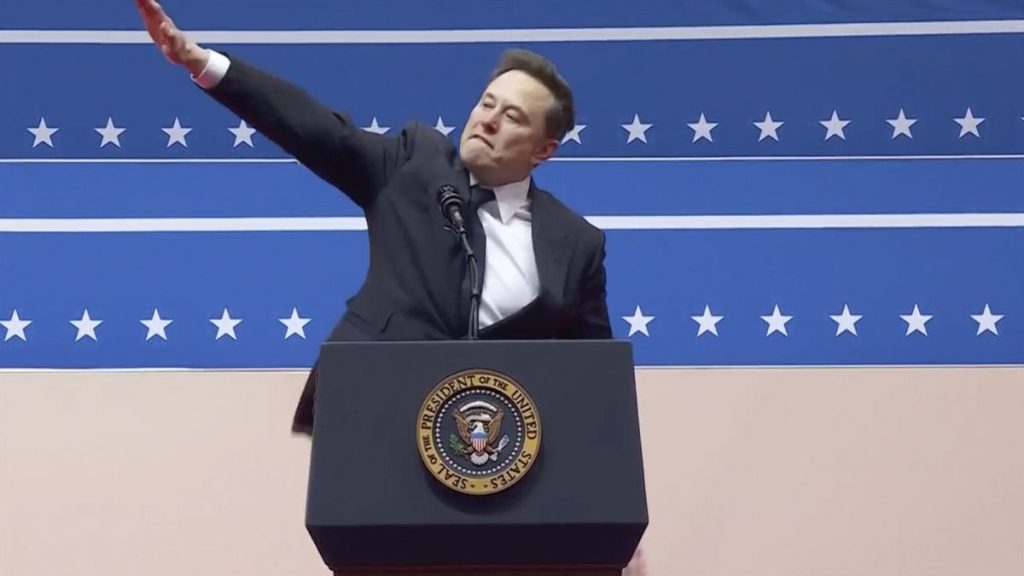Elon Musk’s gesture at Donald Trump’s inauguration rally, resembling both the Roman and Nazi salutes, ignited a whirlwind of speculation and condemnation. The gesture, a chest thump followed by a rigid arm extended forward with palm down, performed twice, was interpreted by some as a blatant display of fascist sympathies, while others dismissed it as an impulsive act devoid of political meaning. This ambiguity fueled a heated debate about the gesture’s historical context, its potential implications, and Musk’s intentions.
Historically, the straight-armed salute originated in ancient Rome, though its actual practice in that era is debated. It was later resurrected by Benito Mussolini’s fascist regime in Italy and subsequently adopted by Nazi Germany, becoming inextricably linked with totalitarian ideologies. The gesture’s resemblance to the Bellamy salute, once used during the US Pledge of Allegiance, prompted its replacement in 1942 to avoid any association with fascism. Today, the salute remains a potent symbol of Nazi ideology, outlawed in many European countries due to its connection to hate groups and historical atrocities. Its use continues within contemporary neo-fascist circles, highlighting the gesture’s enduring power as a symbol of extremist ideology.
Historians offer nuanced perspectives on Musk’s gesture. Some argue that technical differences, such as Musk’s gaze following his hand rather than staring straight ahead, distinguish it from a formal Nazi salute. Furthermore, they contend that Trump, despite exhibiting certain authoritarian tendencies, doesn’t embody the full spectrum of fascist ideology, such as a desire to forcibly expand national territory or militarize society. Others acknowledge the potentially dangerous implications of normalizing such gestures, even in the absence of fully formed fascist intent, noting the potential erosion of democratic norms and values like truth, justice, and fairness. Some scholars label the gesture a “masculine display of celebration with ideological underpinnings,” reflecting a broader alignment with Trump’s “megalomaniac ideologies” without necessarily constituting outright fascism. The key distinction lies in the lack of a comprehensive fascist political agenda aimed at establishing a “new world order,” despite exhibiting certain characteristics associated with such ideologies, such as xenophobia and disregard for the rule of law.
Adding to the complexity are online hate experts who offer differing opinions. Some express skepticism about Musk intentionally performing a fascist salute, citing the unlikelihood of such self-sabotage. Conversely, others interpret the gesture as deliberate and belligerent, highlighting the repeated nature of the action as evidence of intent. This divergence of interpretation extends to organizations like the Anti-Defamation League (ADL), whose dismissal of the gesture as unintentional sparked further criticism, with some accusing them of downplaying a clear display of Nazi symbolism.
Regardless of intentionality, the gesture resonated within neo-Nazi and white supremacist groups, who celebrated it as a sign of validation and a harbinger of their resurgence. Groups such as White Lives Matter and Blood Tribe embraced the gesture, while far-right online platforms like Gab used the image to bolster their narratives. This reaction underscores the potential for ambiguous symbolic actions, even if unintentional, to be appropriated and amplified by extremist groups, furthering their agendas and normalizing their rhetoric within broader society. This incident serves as a reminder of the power of symbols and the need for careful consideration of their historical context and potential impact.
The incident underscores the increasing normalization of far-right rhetoric and the blurring lines between mainstream political discourse and extremist ideologies. Trump’s pardoning of individuals convicted of assaulting police officers during the January 6th Capitol attack, and his refusal to condemn extremist groups like the Proud Boys and Oath Keepers, are cited as examples of this trend. While Trump’s vision of “illiberal democracy” may not be synonymous with classical fascism, his actions and associations contribute to a climate where extremist views gain greater acceptance. This raises concerns about the potential for such normalization to embolden extremist groups and further erode democratic norms.
The debate surrounding Musk’s gesture highlights the complexities of interpreting symbolic acts within a charged political landscape. While historians and experts offer differing perspectives on the gesture’s meaning and intent, its reception within extremist communities underscores its potential consequences. The incident serves as a cautionary tale about the power of symbols, the importance of considering historical context, and the potential for ambiguous actions to be exploited by those seeking to normalize extremist ideologies. Ultimately, the controversy surrounding the gesture transcends a simple discussion of intent, raising broader questions about the evolving nature of political discourse and the challenges of combating the insidious rise of extremist rhetoric in the digital age.














